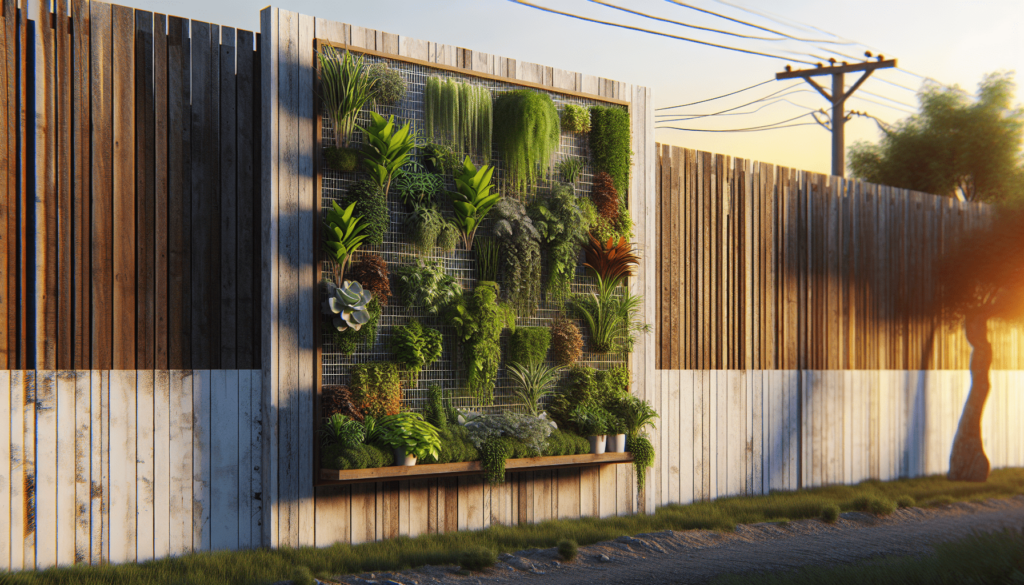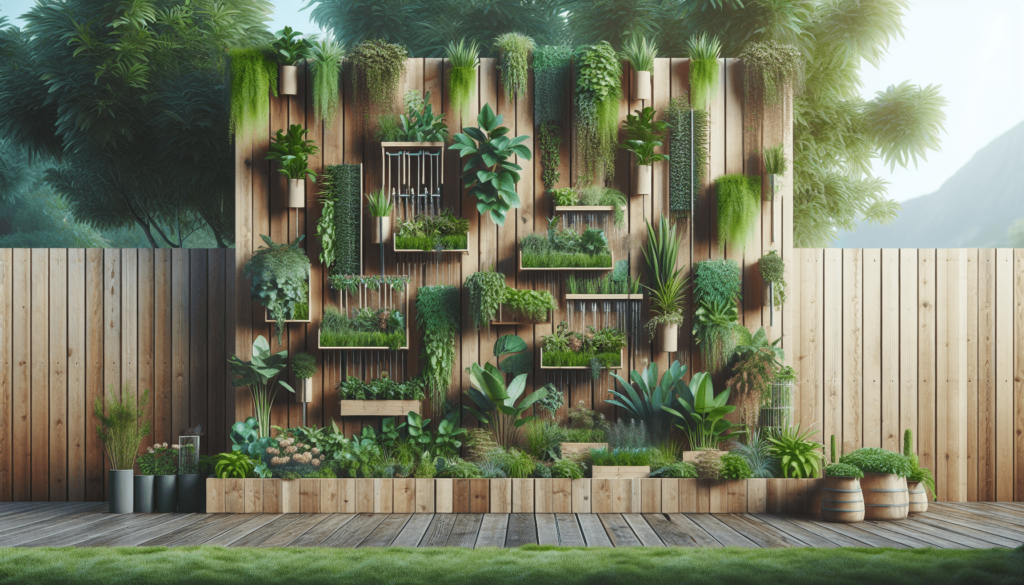Disclosure: As participants in the Amazon Associates Program, we earn from qualifying purchases. This means when you click on an Amazon link on this page and make a purchase, we receive a commission. This doesn’t affect the price you pay but it does help us to keep producing the content you love to see. We always aim for honesty and transparency in everything we do, and your support means the world to us. Thank you for helping us grow and for being part of our community.
Are you looking to add a touch of lush greenery to your fence, but wondering if a vertical garden kit is the right solution? Look no further! Our comprehensive FAQ section is here to guide you through the ins and outs of using a vertical garden kit on a fence. From choosing the perfect kit for your space to understanding the maintenance required, we’ve got all the answers you need to create a thriving vertical oasis on your fence. Join our growing community of vertical gardening enthusiasts and let’s embark on this green venture together!

This image is property of images.pexels.com.
Benefits of using a vertical garden kit on a fence
Enhances aesthetic appeal
Using a vertical garden kit on a fence can significantly enhance the aesthetic appeal of your outdoor space. Instead of a plain and boring fence, a vertical garden adds a touch of natural beauty and vibrant colors. It creates a visually appealing focal point and transforms an ordinary fence into a stunning living wall. The lush greenery and blooms of various plants can create a soothing and inviting atmosphere, making your outdoor area more welcoming and enjoyable.
Maximizes space utilization
One of the key benefits of using a vertical garden kit on a fence is the ability to maximize space utilization. Vertical gardens take advantage of the vertical space, allowing you to grow plants even if you have limited ground space. By utilizing the unused wall or fence space, you can create a thriving garden without sacrificing valuable floor area. This is particularly beneficial for those who have small yards or balconies but still want to indulge in their love for gardening.
Provides privacy and sound insulation
In addition to enhancing the visual appeal of your outdoor space, a vertical garden kit on a fence can also provide privacy and sound insulation. The dense foliage and plants act as a natural barrier, shielding your yard from prying eyes and creating a sense of seclusion. The strategic placement of tall plants and climbers can help block unwanted views and create a private oasis. Moreover, the plants can also absorb and muffle sounds, reducing noise pollution and creating a more peaceful environment.
Offers ease of maintenance
Vertical garden kits on fences typically offer ease of maintenance compared to traditional garden beds. The plants are conveniently positioned at eye level, allowing easy access for watering, pruning, and other maintenance tasks. This eliminates the need to bend down or kneel, making gardening activities more comfortable and convenient. The vertical orientation of the garden also helps with airflow, minimizing the risk of plant diseases and pests. Furthermore, many vertical garden kits come with built-in irrigation systems, making watering a breeze and ensuring that your plants receive the right amount of moisture.
Types of vertical garden kits suitable for fences
When it comes to vertical garden kits suitable for fences, there are various options available to choose from. Here are three common types:
Wall-mounted vertical garden kits
Wall-mounted vertical garden kits are designed to be affixed directly onto the surface of the fence. These kits often feature modular panels or pockets that can accommodate a wide range of plants. They are typically made from durable materials such as plastic or metal, ensuring longevity and stability. Wall-mounted kits offer versatility, as they can be easily customized and rearranged to suit your aesthetic preferences and plant selections. They are a popular choice for those who want a streamlined and organized look for their vertical garden.
Hanging vertical garden kits
Hanging vertical garden kits utilize hanging baskets or planters that are suspended from the fence. These kits are ideal for those who want a more flexible and adjustable vertical garden. Hanging baskets come in various sizes and styles, allowing you to create a unique and cascading display of plants. They are easy to install and can be placed at different heights, offering a visually dynamic and eye-catching garden. Hanging vertical garden kits are perfect for growing trailing plants and vines, adding a touch of whimsy and charm to your outdoor space.
Mesh or grid-based vertical garden kits
Mesh or grid-based vertical garden kits involve attaching a mesh or grid structure to the fence, allowing plants to grow and intertwine within the framework. These kits offer a more organic and natural look, as the plants can be arranged freely and grow in a more unrestrained manner. The mesh or grid provides support for climbing plants, creating a stunning vertical garden with cascading foliage. This type of kit is great for those who prefer a wilder and more untamed look for their vertical garden.

This image is property of images.pexels.com.
Key considerations before using a vertical garden kit on a fence
Before installing a vertical garden kit on a fence, there are several important factors to consider. These considerations can help ensure the success and longevity of your vertical garden.
Weight capacity of the fence
First and foremost, it is crucial to consider the weight capacity of the fence. Different fences have varying levels of strength and stability, and not all fences may be able to support the weight of a vertical garden kit. Before proceeding with the installation, assess the structural integrity of the fence and consult with a professional if necessary. It is important to ensure that the fence can safely hold the weight of the plants, soil, and other components of the vertical garden kit.
Available sunlight
Another key consideration is the availability of sunlight in the chosen location for the vertical garden. Most plants require a certain amount of sunlight to thrive, so it is important to select a spot on the fence that receives adequate light. Observe the area throughout the day to determine the amount of sunlight it receives. Consider factors such as the direction the fence is facing and any potential shading from nearby structures or trees. Choosing a spot with optimal sunlight will greatly contribute to the health and growth of your plants.
Watering and drainage considerations
Proper watering and drainage are essential for the well-being of plants in a vertical garden. Before installing the kit, it is important to consider how you will water the plants and how excess water will be drained. Some vertical garden kits come with built-in irrigation systems, making watering more convenient and efficient. If the kit does not have a built-in system, you will need to ensure that watering the plants is feasible and does not cause damage to the fence or surrounding area. Additionally, consider the drainage capabilities of the fence to prevent water accumulation and potential damage.
Maintenance accessibility
Consider the accessibility of the vertical garden kit for maintenance purposes. Ensure that the plants are easily reachable for watering, pruning, and other care routines. If the kit is installed at a height that is difficult to access, maintenance tasks may become challenging and time-consuming. Assess your own physical limitations and comfort level when determining the height and location of the vertical garden kit. Additionally, consider the ease of disassembling or rearranging the kit if necessary.
Installation process of a vertical garden kit on a fence
Installing a vertical garden kit on a fence can be a straightforward process if done correctly. Here are the steps involved:
Preparing and cleaning the fence
Before installing the vertical garden kit, it is important to prepare and clean the fence surface. Remove any dirt, debris, or loose paint that may interfere with the installation. Use a brush or pressure washer to thoroughly clean the fence, ensuring a smooth and clean surface for attaching the kit. Allow the fence to dry completely before proceeding to the next step.
Choosing the right attachment method
Selecting the appropriate attachment method is crucial to ensure the stability and security of the vertical garden kit. The attachment method will depend on the type of kit and the material of the fence. Common attachment methods include hooks, brackets, screws, or zip ties. Consult the manufacturer’s instructions or guidelines for the specific kit you are using to determine the recommended attachment method. Ensure that the chosen method is suitable for the weight and structure of the kit, as well as the material of the fence.
Securing the vertical garden kit to the fence
Once you have chosen the attachment method, carefully and securely attach the vertical garden kit to the fence. Follow the manufacturer’s instructions for proper installation, ensuring that the kit is aligned and level. Use the appropriate tools and hardware to securely fasten the kit to the fence. Take extra care to ensure that the attachment is strong and stable, especially if the vertical garden kit is heavy or if the fence is subjected to strong winds or other environmental factors.

This image is property of images.pexels.com.
Plant selection for a vertical garden kit on a fence
choosing the right plants for your vertical garden kit on a fence is crucial for the success and aesthetics of the garden. Here are some important considerations when selecting plants:
Choosing plants suitable for vertical growth
When selecting plants for a vertical garden kit on a fence, it is important to choose species that are well-suited for vertical growth. Look for plants that have a natural tendency to climb, such as vines, climbers, and trailing plants. These plants will be able to grow and flourish in a vertical garden environment, attaching themselves to the fence or trellis of the kit. Consider plants with strong and flexible stems that can easily wrap around the support structure. Depending on your preferences, choose a mix of flowering plants, foliage plants, and herbs to create a diverse and visually interesting vertical garden.
Considerations for sun exposure and shade
Take into account the sun exposure and shade conditions of the chosen location for the vertical garden. Different plants have varying light requirements, so it is important to choose plants that are compatible with the available sunlight. Some plants thrive in full sun conditions, while others prefer partial shade or shade. Ensure that the plants you select can tolerate the amount of sunlight they will receive in the chosen spot on the fence. Observe the area throughout the day to determine the intensity and duration of sunlight.
Maintenance and pruning requirements
Consider the maintenance and pruning requirements of the plants you choose for the vertical garden kit. Some plants may require more frequent pruning to control their growth and prevent them from overtaking the space. Choose plants that are manageable in terms of maintenance, especially if accessibility to the vertical garden is limited. Consider the growth rate of the plants and how they will interact with each other in the vertical garden. Select plants that are compatible in terms of growth habit and pruning needs, ensuring a harmonious and well-maintained garden.
Watering and drainage techniques for a vertical garden kit on a fence
Proper watering and drainage are essential for the health and success of a vertical garden kit on a fence. Here are some techniques to consider:
Drip irrigation systems
Drip irrigation systems are a popular choice for vertical gardens as they provide a consistent and efficient method of watering. These systems deliver water directly to the base of the plants, ensuring that they receive the proper amount of moisture without wasting water. Drip irrigation systems can be easily installed in a vertical garden kit, providing a hassle-free way to water the plants. The system can be connected to a timer or automated controller, allowing for precise and scheduled watering.
Self-watering vertical garden kits
Another option to consider is a self-watering vertical garden kit. These kits have built-in reservoirs or watering systems that provide a continuous supply of water to the plants. The excess water is collected in a reservoir and can be reused, minimizing water wastage. Self-watering kits are convenient for those who have busy schedules or may have difficulty watering their vertical garden regularly. They ensure that the plants receive a consistent water supply, reducing the risk of underwatering or overwatering.
Drainage solutions to prevent water damage to the fence
To prevent water damage to the fence, it is important to incorporate proper drainage in the vertical garden kit. Excess water should be able to drain efficiently and not accumulate around the fence. The design of the kit should include drainage holes or channels to allow water to flow out. Consider using a layer of gravel or small stones at the base of the kit to improve drainage. Additionally, periodically check the drainage system and ensure that it is not blocked or obstructed by debris or plant roots.

Maintenance tips for a vertical garden kit on a fence
Regular maintenance is essential for the health and longevity of a vertical garden kit on a fence. Here are some tips to keep your vertical garden thriving:
Regular pruning and trimming
Regular pruning and trimming are necessary to maintain the shape and size of the plants in the vertical garden. Monitor the growth of the plants and trim any overgrown branches or foliage. This will prevent the garden from becoming overcrowded and ensure that each plant receives adequate light and air circulation. Pruning also helps promote new growth and can be done to remove any dead or diseased parts of the plants. Use sharp and clean pruning tools to prevent the spread of diseases.
Fertilization schedule
Establish a fertilization schedule for your vertical garden to provide essential nutrients for the plants. Use a balanced and slow-release fertilizer to promote healthy growth and vibrant blooms. Follow the manufacturer’s instructions for the appropriate amount and frequency of fertilization. It is important not to over-fertilize, as this can lead to nutrient imbalances and damage to the plants. Regularly monitor the condition of the plants and adjust the fertilization schedule as needed.
Checking and adjusting irrigation systems
Regularly check and adjust the irrigation system of your vertical garden kit to ensure that the plants are receiving the proper amount of water. Monitor the moisture levels of the soil and make any necessary adjustments to the watering schedule or duration. Take into account factors such as seasonal changes, temperature fluctuations, and rainfall when adjusting the irrigation system. Regularly inspect the system for any leaks, clogs, or malfunctions and promptly address any issues.
Monitoring for pests and diseases
Keep a close eye on your vertical garden for any signs of pests or diseases. Inspect the plants regularly for pests such as aphids, mealybugs, or mites. If pests are detected, take appropriate measures to control and eliminate them, such as using organic insecticides or introducing natural predators. Additionally, monitor the plants for any signs of disease, such as wilting, discoloration, or abnormal growth. Promptly diagnose and treat any diseases to prevent their spread to other plants. Regularly remove any dead or diseased foliage to maintain the overall health of the garden.
Potential challenges of using a vertical garden kit on a fence
While there are numerous benefits to using a vertical garden kit on a fence, there are also a few potential challenges to be aware of:
Limited sunlight exposure
One of the main challenges of using a vertical garden kit on a fence is limited sunlight exposure, especially if the fence is located in a shaded area or is obstructed by nearby structures or trees. Some plants may require a certain amount of direct sunlight to thrive and may struggle in areas with limited light. It is important to choose plants that are suitable for low light conditions if your fence receives minimal sunlight. Consider factors such as the orientation of the fence and the surrounding environment when selecting plants.
Weight restrictions and fence stability
The weight of a vertical garden kit, especially when fully planted and watered, can put additional stress on the fence. It is important to consider the weight capacity of the fence and ensure that it can safely support the vertical garden. Some fences may have weight restrictions, and exceeding these limits may compromise the stability and integrity of the fence. Consult with a professional if you are unsure about the weight capacity of your fence or if you have concerns about its stability.
Potential damage to the fence
Another potential challenge is the risk of damage to the fence caused by the vertical garden kit. The attachment method used to secure the kit, if not done properly, can result in damage to the fence material, such as wood splintering or metal denting. Additionally, if the vertical garden is not properly maintained or if excess water accumulates, it can cause decay or rotting of the fence. Regularly inspect the fence for any signs of damage and address any issues promptly to ensure the longevity of both the fence and the vertical garden.

Tips for maximizing the benefits of a vertical garden kit on a fence
To maximize the benefits of a vertical garden kit on a fence, here are some tips to consider:
Combining different plant textures and colors
To create an eye-catching and visually dynamic vertical garden, combine plants with different textures and colors. Mix foliage plants with different leaf shapes and sizes, such as ferns, succulents, and ornamental grasses. Intersperse flowering plants with vibrant blooms to add pops of color to the garden. The contrast and variety in plant textures and colors will create a visually stimulating and aesthetically pleasing vertical garden.
Utilizing vertical space with hanging baskets or shelves
In addition to the vertical garden kit itself, consider utilizing additional vertical space on the fence with hanging baskets or shelves. Hanging baskets can be attached to hooks or brackets on the fence, providing an opportunity to grow trailing plants or additional flowers. Shelves can be installed at different heights, allowing for the display of potted plants or decorative items. Utilizing these vertical elements will maximize the available space on the fence and create a multi-dimensional and lush garden.
Creating visual focal points
Use the vertical garden kit on the fence to create visual focal points in your outdoor space. Arrange plants with different heights, colors, and textures to draw the eye and create visual interest. Consider adding decorative elements, such as trellises, plant stands, or artwork, to further enhance the focal points. By strategically placing plants and accessories, you can create a captivating and inviting space that will be the highlight of your garden.
Inspiring ideas for vertical garden kits on fences
Here are some inspiring ideas to get your creative juices flowing when it comes to vertical garden kits on fences:
Herb gardens on fences
Transform your fence into a functional and aromatic herb garden. Utilize a wall-mounted vertical garden kit and plant a variety of herbs such as basil, rosemary, thyme, and mint. The herbs will not only provide a fresh and fragrant ambiance to your outdoor area but can also be conveniently harvested for culinary purposes. Label each herb for easy identification and create a mini herbal oasis that combines both aesthetics and practicality.
Floral displays and color gradients
Create a stunning display of flowers on your fence with a carefully selected mix of flowering plants. Choose plants with different bloom times and colors to create a dynamic and ever-changing vertical garden. Create color gradients by arranging plants in a gradual transition from one hue to another. This will create a visually pleasing and cohesive look, reminiscent of a living rainbow. Experiment with different flower varieties and combinations to achieve the desired effect.
Vertical garden art installations
Take your vertical garden on the fence to a whole new level by incorporating art installations. Consider adding decorative elements such as trellises, wall hangings, or sculptures to create a unique and personalized vertical garden. Combine the beauty of nature with artistic elements to evoke a sense of wonder and creativity. Plant climbing vines that naturally interweave with the art pieces, making the vertical garden a living work of art.
In conclusion, using a vertical garden kit on a fence offers numerous benefits, from enhancing the aesthetic appeal and maximizing space utilization to providing privacy and sound insulation. By carefully selecting the right type of kit, considering important factors before installation, choosing appropriate plants, and implementing proper watering and maintenance techniques, you can successfully create a thriving and visually appealing vertical garden on your fence. With careful planning and creativity, your fence can become a stunning backdrop for a lush and vibrant vertical oasis.







